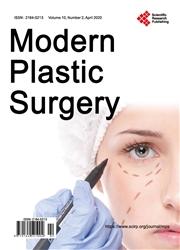Upper Footprint Dependent Nipple Position to Avoid High-Riding Nipple after Reduction Mammoplasty
引用次数: 0
Abstract
Introduction: High-riding nipple following reduction mammoplasty is a challenging problem for the plastic surgeons. To avoid such problem, many methods have been described for marking the correct nipple position but still controversial. We aimed in this study to present our experience in preventing excessive nipple elevation after reduction mammoplasty by using the upper footprint to set the new nipple position. Material and Methods: From March 2019 to March 2022, 25 female patients at a mean age of 38.3 years were included in this prospective study. They underwent reduction mammoplasty with inverted T scar and a combination of inferior pedicle and Würinger’s septum techniques. Resection weights, pre- and postoperative anthropometric measures were recorded. All patients were photographed at the follow-up visits and evaluated for complications if any, the nipple-areola complex (NAC) sensation, and subjective patient satisfaction using “The Breast Evaluation Questionnaire”. Results: The mean preoperative midclavicular point to nipple distance was 37.40 and 37.18 cm for the right and left breasts, respectively. The mean resection weight was 1270 and 1242 g from the right and left sides, respectively. None of our patients experienced NAC necrosis, while 2 breasts had minor wound dehiscence treated conservatively. After a mean follow-up period of 12 months, the NAC descended by an average of 1.40 cm, the distance from the IMF to nipple had乳房缩小术后乳头位置依赖于上脚印以避免乳头过高
乳房缩小术后乳头隆起是整形外科医生面临的一个难题。为了避免这样的问题,已经描述了许多方法来标记正确的乳头位置,但仍然存在争议。我们的目的是在这项研究中介绍我们的经验,防止乳头过度抬高缩乳术后使用上脚印设置新的乳头位置。材料与方法:本前瞻性研究纳入2019年3月至2022年3月25例女性患者,平均年龄38.3岁。他们接受了乳房缩小成形术与倒T型疤痕和结合下蒂和林格鼻中隔技术。记录切除体重、术前和术后人体测量值。所有患者在随访时拍照,并使用“乳房评估问卷”评估并发症(如有)、乳头乳晕复合体(NAC)感觉和主观患者满意度。结果:术前右、左乳房锁骨中点至乳头的平均距离分别为37.40、37.18 cm。右侧和左侧平均切除重量分别为1270和1242 g。本组患者均无NAC坏死,2例乳房有轻微创面裂开,经保守治疗。在平均12个月的随访期后,NAC平均下降了1.40厘米,即从IMF到乳头的距离
本文章由计算机程序翻译,如有差异,请以英文原文为准。
求助全文
约1分钟内获得全文
求助全文

 求助内容:
求助内容: 应助结果提醒方式:
应助结果提醒方式:


